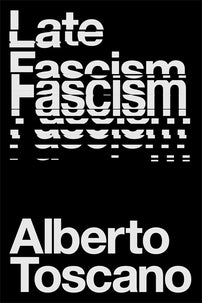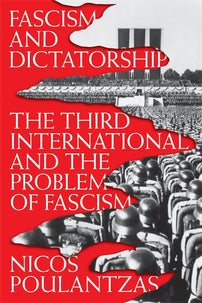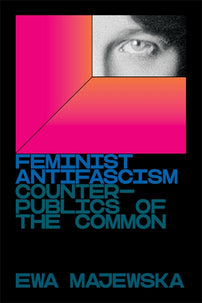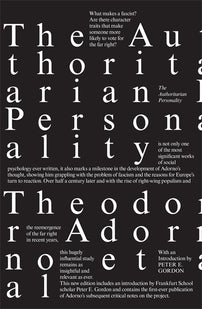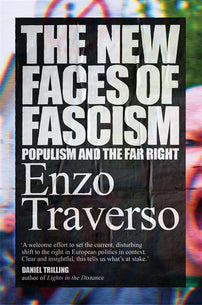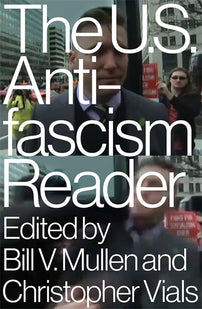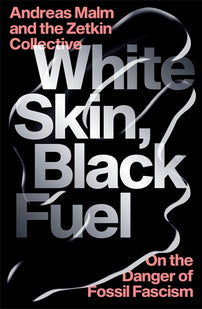The Fascist Disposition
What does the word “fascism” mean today, when fossil capitalism continues its accelerated march toward a climate catastrophe and the liberal democracies of North America and Europe support and arm Israel’s genocide of Palestinian people in Gaza?

This essay is the third in a roundtable discussion of Alberto Toscano’s Late Fascism. The others, from Jordy Rosenberg and Lisa Lowe, can be found here and here.
In his powerful book Late Fascism, Alberto Toscano offers us a conceptual and political diagnosis of the emergence in new form of old fascist desires and impulses, a phenomenon he names “late fascism.” Toscano’s main premise is as straightforward as it is crucial: that liberalism and fascism, rather than being polar opposites, have been profoundly entangled with each other in the history of racial capitalism. And he adds that what we call “fascism” cannot be reduced to the ideologies and political regimes that defined it in the Europe of the 1930s and 1940s because it is primarily a type of desire, an eros, or what I would call an affective disposition, a propensity to make the body act in a particular way. Toscano builds his persuasive argument through an extraordinary archival work that examines and rescues multiple, often forgotten genealogies of anti-fascist, Black, and anti-white supremacist thought and action, helping us appreciate the incredible intellectual work of our anti-fascist predecessors and the importance of their insights for understanding the rise of the neo-liberal fascisms of the twenty-first century.
[book-strip index="1"]
Toscano’s opening and key point is that we must examine fascism, in its past and present iterations, primarily in order to better articulate an anti-fascist politics. Hence the question he poses early on, “What is the connection between the theorising or naming of fascism and anti-fascist strategies?”. The book demonstrates that anti-fascist strategies cannot be reduced to defending liberal democracy, to choose Biden over Trump, for liberalism and fascism are both inseparable from capitalism’s social and affective formations. The clearest and most recent example are of course the liberal leaders of the United States, Canada, and Europe supporting and arming the fascist government of Netanyahu as it unleashes racialized terror and ethnic cleansing in Palestine. Drawing from many thinkers who have thought long and hard about previous manifestations of fascist and white supremacist violence, Toscano demonstrates that to speak of fascism is to speak of capitalism, and that anti-fascism should necessarily be anti-capitalist—an idea that will certainly horrify liberal-progressive critics of fascism. Hence the importance of the last lines of the book, where he writes: “Whoever is not willing to talk about anti-capitalism should also keep quiet about anti-fascism.” The reason is that anti-fascism “is not just a matter of resisting the worst,” but “the collective forging of ways of living that can undo the lethal romances of identity, hierarchy and domination that capitalist crises throw up with such grim regularity”.
This view of fascism as a “lethal romance of identity, hierarchy and domination” takes us to another major thread in the book: that fascism should be examined not just as a socio-political or ideological phenomenon but also, in Toscano’s words, as a “psychic and libidinal phenomenon”: that is, as a type of desire, “an erotic charge.” The libidinal dimensions of fascism have been noted by many authors, for instance Foucault when he wrote that many people desire fascism and strive toward it, “desiring the very thing that dominates and exploits us.”[1] In different historical moments and places, fascist desires have been celebrated and rationalized through very different ideologies, symbols, and narratives. But these dispositions tend to share a family resemblance, which means that the affects that guide the far right in Argentina, Israel, the United States and Brazil are commensurable (but not identical) with each other, which explains the love that Argentina’s President Javier Milei has publicly expressed for men like Netanyahu, Trump, and Bolsonaro. Below I’ll return to the case of Milei as a recent embodiment of this blend between extreme neoliberalism and fascism.
Inspired by the Black radical tradition, Toscano’s decisive analytical and political move is to compare contemporary fascisms not so much with the “classic” European fascisms of the 1930s and 1940s (a recurring comparison by mainstream commentators) but rather with the terror that in centuries prior European powers unleashed on colonized and racialized people the world over. One of the epigraphs that opens up Late Fascism is by Langston Hughes, who said in 1936: “Fascism is the new name for that kind of terror the Negro has always faced in America.” This also brings to mind what Aimé Césaire argued in Discourse on Colonialism: that Europeans “tolerated” the type of savagery unleashed by Nazism before they became their victims, for “they absolved it, they shut their eyes to it, they legitimated it because until then it had been applied only against non-European peoples.” This liberal and white supremacist exoneration of fascist terror unleashed on non-white bodies, this looking away from the colonial horrors of “western civilization,” resonates all too painfully with the ongoing genocide in Gaza, which reveals the continuities between different genocides and the fact that fascist drives also imply a de-sensitization toward the suffering of victims who have been dehumanized. This affective selectivity of fascist dispositions, this capacity to be affected by the death of some but not others, is always historically, geographically, and culturally situated and therefore unique. But this propensity toward racialized brutality is never a purely local and historically situated phenomenon because it also responds to the elemental, affective structures that have long defined fascist dispositions throughout history.
[book-strip index="2"]
While Toscano does not make this point explicitly, I think that’s the direction his book points toward: the exploration of the affective, pre-linguistic core of fascist dispositions worldwide. The fascists of the 1930s and the late fascists of today may be quite different from each other in terms of the symbols, values, and narratives they celebrate. Yet overemphasizing (as many progressives in Argentina do) that Milei is not “really” a fascist because he does not use the language of a 1930s European fascist and identifies as a “libertarian” overlooks what he does share with them: a disposition to justify violence on people felt to be savage, threatening, and inferior, for Milei has repeatedly celebrated the genocide of Indigenous people in Argentina in the late 1800s and today’s genocide of Palestinians by Israel.
The murderous disposition that has long guided fascist desires, however, is not always centralized by the state. Toscano shows that in settler colonial situations this violent desire follows a “logic of delegation” that creates a deputization of violence through the “petty sovereignty” of settlers who exert a microphysics of terror on racialized people—currently embodied by the Israeli settlers in the West Bank. As Toscano aptly puts it: “Fascism is not just the apotheosis of the leader above the sheeplike masses of his followers”. It is this microphysics of everyday terrors, this elemental affective structure, that connects previous manifestations of fascism in Europe and elsewhere with the late fascisms of today.
That old and new expressions of fascist passions share a similar affective disposition certainly does not mean they are all the same, for each and every one of them is, at the same time, historically and geographically unique. Toscano clearly identifies what is historically specific and novel about today’s late fascism: “Late fascism is … both a reaction against certain facets of the neoliberal moment (those to be coded and sometimes racialized as ‘globalist’) and a passionate over-identification with the coercive dimensions of the anti-state state”. This reactive passion is consistently framed, from the United States to Argentina, as a righteous struggle for “freedom,” which coded in a fascist fashion is basically the freedom to dominate racialized others and impose legitimate violence on them. This sad passion for freedom is parallel to a profoundly visceral disgust at equality, or in the words of Toscano “a repulsion for solidarity, care, vulnerability”. Milei embodies this affect, for he has repeatedly said he feels revolted by the idea of “social justice.” The irony is that uber-reactionaries like Milei claim to be “rebels” leading a “libertarian revolution” against la casta (“the caste,” as he calls the political elites that ruled Argentina in the previous two decades) while implementing the most savage looting of public wealth by corporate power in generations, aimed at cementing profound class, racialized, and gender hierarchies.
Further, as Toscano notes, the late fascists who call for “a pseudo-insurgency” are in fact “largely emptied (albeit with important exceptions) of mass movement and utopia” (2). In Argentina, the propensity and desire of many late fascists to inflict violence on racialized others and leftists is parallel to their dislike for mass mobilizations on the streets and their preference for online trolling. The far-right Argentinean author and influencer Agustín Laje, a fan of Milei, recently emphasized how much “pleasure” he felt at seeing “los zurdos” (a derogatory word for leftists) beat up by the riot police. “We celebrate the police, we congratulate them. Each bullet well placed in each zurdo has been for all of us a moment of joy. Each image of a zurdo crying because of pepper spray in their eyes was for us a very pleasurable moment to watch. … Those people deserve to be shot.” Laje’s admission of his own erotic and psychopathic desire to physically hurt “leftists,” and his feeling of joy in watching violence by the police, was followed by a revealing admission: “I’m very scared of the streets, because the Milei supporter is not a violent voter … and is not used to rallies.” He then said that it’s “the other side” (i.e. “leftists”) “which has all the force, brute and anti-democratic physical force.”[2] This is why Laje said it was imperative, and for him a source of pleasure, that the police hurt them. It is precisely this joyful impulse to celebrate physical violence on unarmed protesters that makes of Laje a textbook fascist.
[book-strip index="3"]
And this takes me to another feature of fascist dispositions identified by Toscano: that they are “out of sync,” strangely but revealingly disconnected, in an affective manner, from the surrounding world. Toscano draws here from Ernst Bloch, who wrote in the 1930s that fascist personalities tend to mobilize “non-synchronous people” who are “out of sync” with contemporary rhythms. Toscano shows that in today’s Global North this a-synchronicity has resurfaced in the desires of Trump supporters who express “fantasies of a white, industrial, patriarchal modernity that have the post-fascist, post-war period as their seedbed”. In other words, paradoxically, Trump’s nostalgia for a once “great” United States evokes the times that followed the defeat of fascism in World War II. In Argentina, this a-synchronous nostalgia evokes an even more distant past. When Milei mimics Trump and claims he desires “to Make Argentina Great Again,” he means he seeks to return to the Argentina of the 1880s and 1890s, when following the genocide of Indigenous people his hero General Roca (“The Conqueror of the Desert”) became president and led the efforts to whiten and develop the nation through European immigration. This racialized disposition toward the past is inseparable from Milei’s disregard for the climate crisis in Argentina despite the devastating droughts of the past few years, which makes him dismiss climate change as “a Marxist hoax.”
The final point in Toscano’s argument that is worth noting is his reminder that to speak of fascism is to speak of the fear of revolt and revolution, for fascism is an eminently counter-revolutionary impulse. Yet one of the paradoxes of today’s late fascism, in contrast to the European fascisms of the 1920s and 1930s, is that it has surged when capitalism is not facing a revolutionary threat and the anti-capitalist left is fragmented and politically weak. Toscano therefore asks, “What, we may wonder, is late fascism trying to prevent?” He answers that our late fascism is not a “pre-emptive counter-revolution” (as thinkers like Angela Davis theorized in relation to the neo-fascisms of the 1970s) but a sort of “pre-emptive counter-reform,” given that today the main demands for change are reformist rather than revolutionary in nature. But Toscano draws from these late fascist paranoias to offer a Gramscian way out of the pessimism of the intellect that results from the current balance of power in the world and the ongoing hegemony of fossil capital despite the mounting evidence of a future climate collapse. Appealing to the optimism of the will of those of us who often feel overwhelmed by the power of our enemies, he writes: “On a more optimistic note, that progressive or liberal reforms may appear to racists and reactionaries as signs of a communist dystopia that is almost already here could also be interpreted as the distorted recognition of utopian traces that demand to be blasted out of the continuum of reformism. An ideal for the left might be to become what its enemies think it already is, namely a strategically ingenious and systematic endeavor to undermine white, Western, Christian capitalist civilization across all institutions of society”. And it is in this call to undermine the “capitalist civilization” that is ruining Earth and unleashing genocide on Gaza that anti-fascist and anti-capitalist dispositions could blend and become part of the same collective struggle for life and justice on Earth.
[1] Foucault, Michel. 1977. Preface. In Anti-Oedipus, by Gilles Deleuze and Felix Guattari (pp xi-xiv). Minneapolis: University of Minnesota Press. Page xiii.
[2] Murillo, Euge. 2024. Los goces de Agustín Laje. Página 12 (Buenos Aires), February 9.
